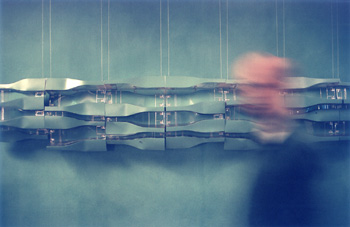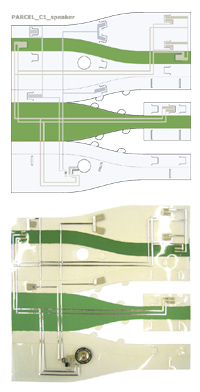updated October 04, 2008
PARCEL

PARCEL presented at the Stockholm Concert Hall in September 2004
View PARCEL show reel , Flash 7, 320x240 px, 2.3 Mb.
Complete PARCEL presentation at www.krets.org!
With PARCEL Krets suggests new ways of establishing relations between the material, audiovisual and digital techniques that are increasingly forming the environments around us. The project considers off-the-shelf technologies normally used in the packaging industry and consumer electronics as integral parts of an architectural design.
Introduction
The PARCEL prototype, a reactive wall-panelling system, borrows its design logic from ubiquitous electronic technology, printed matter and disposable articles. Transferring these strategies to an interior architectural scale introduces an oscillating ambiguity between graphic infrastructures and spatial infrastructures, surfaces for printed circuits and folded volumetric parcels for conduit space and electronic equipment. The multifunctional quality of the graphic pattern provides instructions for the production of the punch tool, for the position of the folds as well as the template for the conduit printing. It thus suggests an ornamental transition from graphic to electronic and spatial infrastructure. PARCEL blurs the relationship between model and building - in this case the wall, and prototype and product - in this case the wall panelling system, in its capability of continuously reacting and interacting electronically with its environment as well as inviting the visitor to recombine and transfigure the system.

pattern and unfolded parcel
The individual and collective spaces of
today are saturated with information networks and control mechanisms,
ranging from automatic doors, to information displays and surveillance
systems. The social protocols of such densely electronic material
are very much dependent on the presence they have in a space. By
appropriating these systems into the architectural design process,
they become part of the overall design agenda, and can be articulated
accordingly.
An extension may lead to new models for social exchange in space,
in analogy with the establishment of internet communities over the
past decade. The question remains, is it possible for electronically
augmented environments to provide a new elastic and reactive materiality,
instead of merely remaining implanted with unarticulated control
mechanisms?

combined stack
PARCEL development
Punched plastic sheets equipped with computational
intelligence through microprocessors, printed circuits, and variations
of sensors, lighting and speakers, are folded into volumes. When
combined they form a wall-paneling system integrating information
technology and infrastructure as well as illumination and sound.
The folded sheets create depth from surface and respond to the color
scheme of the Stockholm Concert Hall. The rendering of the color
shifts as a result of the inherent curvature in the pieces and the
integrated light.
PARCEL is composed by interchangeable components, where each unit has specific characteristics regarding form and operation. The modularity allows recombination according to certain principles, in which each part only matches a selection of the others. This enforces a variation over a larger area, and also gives the potential for dynamic reconfiguration. The physical joints incorporate the electronic network, and PARCEL can expand and contract independent of a separate infrastructure.

production tests
The immaterial characteristics of PARCEL is based on the same principles as the white noise used to control sound conditions in an environment. In this way an acoustic ambience is created, dampening sharp noise. In PARCEL the surrounding sound is picked up locally through microphones, and are dispersed through the integrated network to other parts of the installation. During this transfer the sound signal is altered, and is used to control the generation of the white noise. This noise is finally emitted through loud speakers and lighting, establishing local environments.

folded parcel
The formal logics of the PARCEL prototypes are imported from printed matter and disposable articles, transferring their qualities to an interior scale. The physical and electronic architectures are using similar principles, a cellular and parallel model, which is different from traditional sequential computer processes. The material and immaterial aspects of PARCEL suggests a light mode of operation, where the ambience of an environment can be shifted from one moment to the next.
Project team PARCEL: Pablo Miranda, Daniel
Norell and Jonas Runberger.
Thanks to: Erik Hökby, Mattias Rubin De Lima, Lars Åstrand, Vinkplast
AB and Packningar och Plast AB.
Complete PARCEL presentation at www.krets.org!
View PARCEL show reel at Myspace.